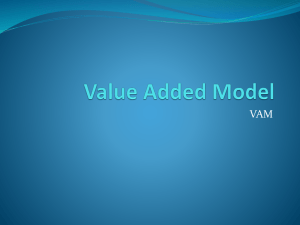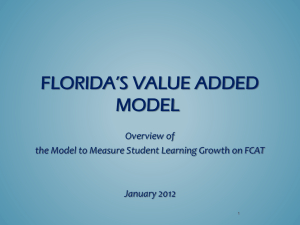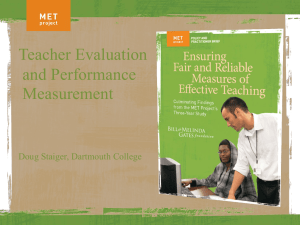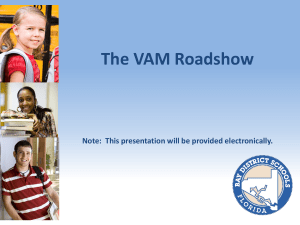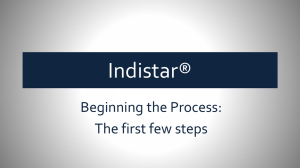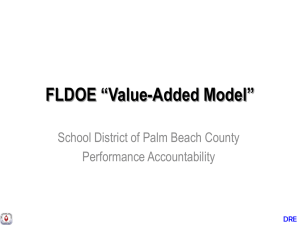VAM Presentation - updated 11/20/12
advertisement
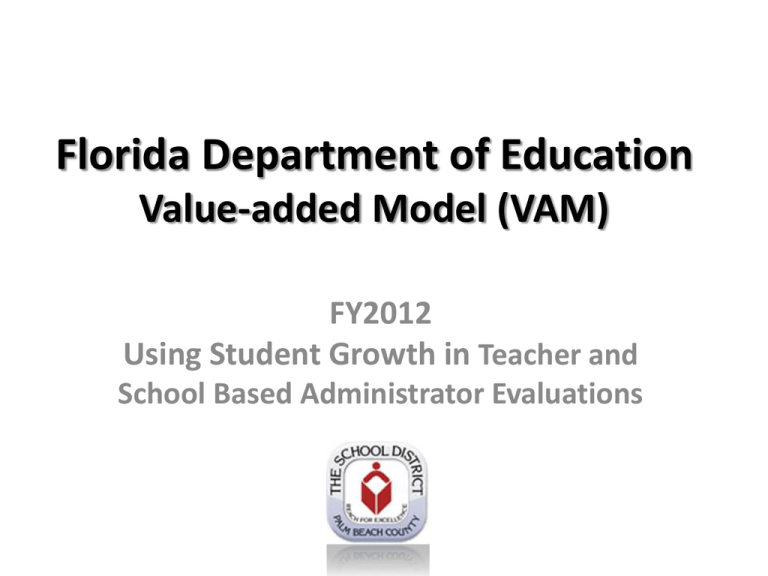
Florida Department of Education Value-added Model (VAM) FY2012 Using Student Growth in Teacher and School Based Administrator Evaluations HOW DID WE GET HERE? • Established by Student Success Act (SB 736) Educator Evaluation System http://www.flsenate.gov/Committees/BillSummaries/2011/html/0736ED • Teacher and School Administrator Evaluations – Professional Practice – Student Learning Growth • FLDOE Student Growth Implementation Committee (SGIC) http://www.fldoe.org/committees/sg.asp Established by Student Success Act (SB 736) Teacher Evaluation System Instructional Practice (IP) (4) Highly Effective (3) Effective (2) Needs Improvement (1) Unsatisfactory Student Learning Growth (SLG) (4) Highly Effective (3) Effective (2) Needs Improvement (1) Unsatisfactory 2012 Weights Teacher IP = 60%/SLG = 40% Administrator IP = 50%/SLG = 50% Final Rating 4-HE 3-Eff 2-NI 1-U FY2012 Implementation • • • • • Required by law First time used in evaluations Based only on FCAT 2.0 Reading/Math No Algebra 1 EOC student growth scores No teacher or school administrator will receive a student growth rating less than Effective IMPORTANT! It is important to note that measures used in the Florida School Grading system, student proficiency and learning gains, are not a part of the Florida Value-added Model of student learning growth. Student learning growth is based on the actual scale score on FCAT 2.0 tests. Even if students already score in Achievement Levels 3-5, they still have room to grow. Growth vs. Proficiency Growth (Progress) Proficiency (Status) Growth models measure A method for measuring the amount of academic how students perform at progress students make one point in time between two points in time Growth vs. Proficiency TEACHER 1 500 450 TEACHER 2 500 450 Proficiency 400 Proficiency 400 350 350 Growth 300 300 250 250 200 200 150 150 100 100 50 50 0 0 Stu A Stu B Prior Stu C Stu D Current Stu E Stu F Stu G Prior Stu H Stu I Current Stu J Growth vs. Learning Gains 260 257 250 240 230 251 Level 4 243 237 248 220 Proficiency 246 Learning Gain 210 200 Grade 6 Reading Grade 7 Reading Growth vs. Learning Gains 260 257 250 240 230 251 Level 4 243 237 248 220 Proficiency Growth 246 Learning Gain 210 200 Grade 6 Reading Grade 7 Reading A More Complete Picture of Student Learning Growth Proficiency > Compare student to own prior performance > Compare student to a standard > Consider student characteristics > Progress between points > Critical to student success & > Does not consider student characteristics > Performance at a point in time > Critical to postsecondary opportunity Establishes Overview Teacher: Aggregate of Students Taught Score Used to Rank Teacher Used for Evaluation Student Growth Establishes Score School: Aggregate of Students Enrolled Used to Rank School Used for Evaluation VAM & Student Learning Growth • Contribution to a change in a student’s achievement on standardized test • Calculated from a measure of student learning growth over time http://www.fldoe.org/committees/sg.asp What is the Student Learning Growth Score? The difference between Current test score and Predicted test score What is the Predicted Student Score? What is the Predicted Student Score? Student score expected based on prior tests and other characteristics FLDOE Value-Added Model Variables determining predicted score • • • • • • Two or more years of prior achievement scores Gifted status Class size Student Attendance (Days) Mobility (number of transitions) Difference from modal age in grade (indicator of retention) • The number of subject-relevant courses in which the student is enrolled • Homogeneity of entering test scores in the class OTHER CHARACTERISTICS? http://www.fldoe.org/committees/sg.asp FLDOE Value-Added Model Variables determining predicted score • • • • • • Two or more years of prior achievement scores Gifted status Class size Student Attendance (Days) Mobility (number of transitions) Difference from modal age in grade (indicator of retention) • The number of subject-relevant courses in which the student is enrolled • Homogeneity of entering test scores in the class http://www.fldoe.org/committees/sg.asp FLDOE Value-Added Model Variables determining predicted score • Students with Disabilities (SWD) status – – – – – – – – – – Language impaired Hearing impaired Visually impaired Emotional/behavioral Specific learning disability Dual sensory impaired Autism spectrum disorder Traumatic brain injury Other health impaired Intellectual disability • English Language Learner (ELL) status – LY http://www.fldoe.org/committees/sg.asp FLDOE Value-Added Model Student Success Act specifically excludes these student characteristics • • • • Gender Race Ethnicity Socioeconomic status What is the Student Learning Growth Score? Let’s take a look at the predicted score 800 900 1000… 700 200 300 400 500 600 Y axis is Current Year FCAT Score X axis is Prior Year FCAT Score …100 CURRENT TEST (FY12 FCAT) What is the Predicted Student Score? …100 200 300 400 500 600 700 800 900 1000… PRIOR TEST (FY11 FCAT) 800 900 1000… 900 700 700 600 600 800 300 400 500 500 400 Answer: Average of current scores of similar students 200 300 …100 CURRENT TEST (FY12 FCAT) What is the Predicted Student Score? …100 200 300 400 500 600 700 800 900 1000… PRIOR TEST (FY11 FCAT) 800 900 1000… 700 800 700 PREDICTED SCORE 600 600 500 300 400 500 600 900 400 200 300 …100 CURRENT TEST (FY12 FCAT) Student Learning Growth is the Amount Above or Below Predicted Score …100 200 300 400 500 600 700 800 900 1000… PRIOR TEST (FY11 FCAT) 800 900 1000… 700 600 800 ACTUAL SCORE 700 PREDICTED SCORE 600 Positive Student Growth Score 600 500 400 ACTUAL SCORE Negative Student Growth Score 300 200 300 400 500 900 …100 CURRENT TEST (FY12 FCAT) Student Learning Growth is the Amount Above or Below Predicted Score …100 200 300 400 500 600 700 800 900 1000… PRIOR TEST (FY11 FCAT) Growth vs. Proficiency TEACHER 1 500 Did Student B meet or exceed the predicted score? 450 400 500 450 400 350 350 300 300 250 250 200 200 150 150 100 100 50 50 0 0 Stu A Prior Stu B Stu C Current Stu D Stu E Predicted TEACHER 2 Did Student J meet or exceed the predicted score? Stu F Prior Stu G Stu H Current Stu I Stu J Predicted Student Growth 350 Residual 300 250 200 150 100 50 0 Stu C Prior Current Predicted The difference Residual: between the The amount current and of growth by predicted ascores student represents the value added by the teacher and the school 800 900 1000… 600 700 Example: All Grade 5 Reading Students in Florida 200 300 400 500 The diagonal line is the predicted growth observed among .similar students …100 CURRENT TEST (FY12 FCAT) Determining the Student Learning Growth by School …100 200 300 400 500 600 700 800 900 1000… PRIOR TEST (FY11 FCAT) DRE 800 900 1000… 600 700 The difference between the predicted and actual scores is the growth. 200 300 400 500 The average of the growth of students within a school produces the school score for a subject/grade. …100 CURRENT TEST (FY12 FCAT) Determining the Student Learning Growth by School …100 200 300 400 500 600 700 800 900 1000… PRIOR TEST (FY11 FCAT) Student Growth Scores Teacher VAM School Component Student Growth Scores Teacher/School • State calculates scores for each grade and subject separately • Therefore, a teacher/school may have more than one score Student Growth Scores Teacher/School • Teacher of both 9th and 10th grade students Grade 9 10 Student Subject Count Reading Two 18 Different 16 Reading Scores Teacher VAM 6.04 -0.08 Comparing Scores • Comparing scores across subjects/grades • FCAT 2.0 scale has inconsistencies 12 Average Yearly Growth–FCAT 2.0 Reading Scale Score Gain 10 8 6 4 2 0 Grade 4 Grade 5 Grade 6 Grade 7 Grade 8 Grade 9 Grade 10 Common Score • State creates scores on common scale • Example: Jane Doe teaches intensive reading Grade Subject Student Count 9 10 Reading Reading 18 16 Teacher VAM 6.04 -0.08 Common Score 1.07 -0.01 Common Score • State creates scores on common scale • Example: Jane Doe teaches intensive reading Grade Subject Student Count 9 10 Reading Reading 18 16 Teacher VAM 6.04 -0.08 COMMON SCORE Common Score 1.07 -0.01 .052 Ranking Scores 100 87% - 100% HIGHLY EFFECTIVE 90 80 70 Jane Doe 15% - <87 % EFFECTIVE 60 50 40 30 20 10 2% - <15% DEVELOPING 0 <2% UNSATISFACTORY Schools in 1State Category Category 2 in State Category 3 Teachers Category 4 Jane Doe: Teacher Example 1. Jane Doe’s common score is 0.052 2. This score is ranked among all teachers in the state with a Reading score 3. This gives Jane a percent rank of 68.48 when compared to all other teachers in the State 4. This percent rank translates to “Effective” Percent Ranks and Ratings • State generates a percent rank for each teacher, school, district –Reading score is ranked among all Reading scores in the state (Grades 4-10) –Math score is ranked among all Math scores in the state (Grades 4-8, No Algebra) – Reading + Math score is ranked among Reading + Math scores in the state • Percent ranks are placed on the District Student Growth Rating Scale District Evaluation System Implementation Plan • Teachers – FCAT Teachers use teacher VAM score for students of grade/subjects taught – Non-FCAT Teachers use combined reading/math school score – Teacher assigned to 2 schools, use weighted average of 2 schools combined reading/math scores – Teacher assigned to more than 2 schools, use District reading/math score combined • Administrators – Principals & Assistant Principals use combined reading/math school score Established by Student Success Act (SB 736) Teacher Evaluation System Instructional Practice (IP) (4) Highly Effective (3) Effective (2) Needs Improvement (1) Unsatisfactory Student Learning Growth (SLG) (4) Highly Effective (3) Effective (2) Needs Improvement (1) Unsatisfactory 2012 Weights Teacher IP = 60%/SLG = 40% Administrator IP = 50%/SLG = 50% Final Rating 4-HE 3-Eff 2-NI 1-U Final Teacher Evaluation Rating Instructional Practice (60%) Student Learning Growth (40%) 1 2 3 4 HE 3.2 - 4.0 1 2 3 4 1 1.4 1.8 2.2 Hold Harmless 1.6 2 2.4 2.8 2.2 Hold2.6 Harmless 2.8 3.2 3 3.4 3.6 4 WEIGHTED-AVERAGE Eff NI 2.1 - 3.1 1.2 - 2.0 U 1.0 - 1.1 Final Administrator Evaluation Rating Professional Practice (50%) Student Learning Growth (50%) 1 2 3 4 1 1 1.5 2 2.5 2 1.5 2 2.5 3 3 2 2.5 3 3.5 4 2.5 3 3.5 4 HE 3.2 - 4.0 WEIGHTED-AVERAGE Eff NI 2.1 - 3.1 1.2 - 2.0 U 1.0 - 1.1 Sample School Report Sample teacher report Sample Teacher Report Sample Student Report Resources • Research & Evaluation Website (PPT) • FLDOE Resources on Student Growth – State Educator Evaluation System (Video) – Value-Added Model White Paper (Word, 841KB) – Value-Added Model Technical Report (Word, 601KB) – Presentation on the Value-Added Model (PDF, 103KB) – FDOE - VAM Course Codes used in Value-Added Model • Oak Tree Analogy of Value-added CONTACT Student Growth (VAM) Mark Howard, Director Research, Evaluation and Assessment Mark.howard.1@palmbeachschools.org 561-434-8781 Educator Evaluations Kathy Orloff, Director Professional Development Kathy.orloff@palmbeachschools.org 561-776-3696 Educator Evaluations Dianne Wyatt, Manager Human Resources/Professional Development diane.wyatt@palmbeachschools.org 561-366-6112
